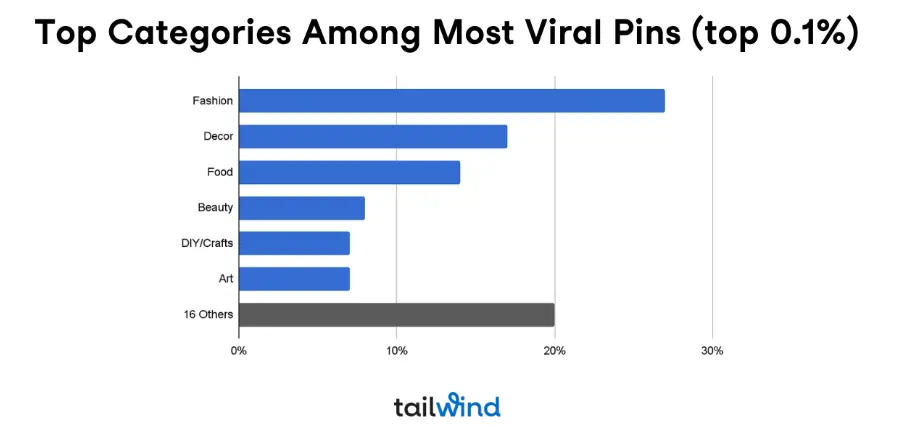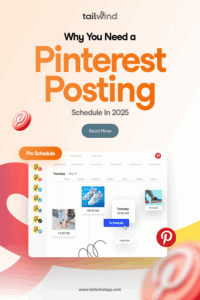
Remember when you could just pin whenever inspiration struck and still see decent results?
Those days are officially behind us. If you’re serious about Pinterest success in 2025, you need a strategic Pinterest posting schedule approach that works with the platform’s evolved algorithm, not against it.
The Pinterest landscape has dramatically shifted over the past year. With the retirement of Idea Pins and billions of impressions now up for grabs, there’s never been a better time to get strategic about your posting schedule. But here’s the thing: random posting won’t cut it anymore.
Recent analysis of over 1 million Pins reveals that the top 1% of Pins drive more than 50% of all impressions and clicks on Pinterest. Translation? Consistency and strategic timing aren’t just nice-to-haves — they’re essential for competing in today’s Pinterest environment.

Let me walk you through exactly why a Pinterest posting schedule strategy is crucial and how to create one that actually moves the needle for your business.
Why a Pinterest Posting Schedule Matters More Than Ever in 2025
Increased competition and algorithm changes have fundamentally altered the Pinterest game. With Idea Pins no longer dominating feeds, traditional image Pins are back in the spotlight, but so is everyone else trying to capitalize on this shift. The platform’s algorithm now heavily favors accounts that demonstrate consistent, high-quality posting patterns.
Here’s what makes 2025 different: Pinterest’s user base has exploded with Gen Z users now comprising over 42% of the platform’s global monthly users. These younger users have different browsing habits, peak activity times, and content preferences compared to Pinterest’s traditional demographic. Your posting schedule needs to account for this demographic shift to maximize reach.
The importance of consistency for reach and engagement cannot be overstated. Fresh Pins (original content created by business accounts) now receive dramatically more distribution than Saves or Repins. Pinterest has essentially restructured their entire content distribution model to reward original creators who post consistently.
Rising demand for evergreen plus seasonal content creates unique scheduling opportunities. While over 60% of saves come from Pins over a year old, seasonal content still drives massive spikes in engagement when timed correctly. Your 2025 posting schedule needs to balance evergreen content that provides long-term value with timely seasonal posts that capture trending interest.

Pinterest’s internal data shows that Pins combining evergreen appeal with seasonal timing (think “cozy winter recipes” or “spring cleaning organization tips”) consistently outperform purely evergreen or purely seasonal content. This hybrid approach is becoming essential for sustained growth.
The platform’s push toward better shopping experiences has also elevated categories like Fashion, Decor, and Beauty to new prominence. If your business operates in these spaces, a strategic posting schedule aligned with shopping seasons and trend cycles becomes even more critical.

How Often Should You Post on Pinterest in 2025?
Here’s where many Pinterest marketers get overwhelmed — and rightfully so. Pinterest officially recommends creators publish 5-25 fresh Pins per day, which sounds absolutely insane if you’re manually creating and posting content.
But let’s break this down realistically. The updated recommendations for 2025 suggest 5-15 Pins per day as the sweet spot for most businesses. This isn’t about churning out mediocre content — it’s about creating enough quality Pins to have multiple chances at viral success.
Remember, Pinterest success is partly a numbers game. Most Pins won’t achieve significant distribution, but the ones that do can drive traffic for years. Publishing more quality content increases your odds of creating those winning Pins that justify the entire effort.
Balancing volume with quality is the real challenge. Recent benchmark data shows that viral Pins share specific characteristics: they’re predominantly vertical image Pins (89% of top performers), use focused keyword strategies, and include alt text. Your posting schedule should prioritize creating Pins that meet these quality standards rather than just hitting arbitrary volume targets.
Here’s a realistic approach for different business sizes:
Small businesses or solo creators: Start with 5-7 Pins per day, focusing on 2-3 original Pins plus new Pins for strategic older content. Tailwind SmartPin makes this easy to do! It boosts your reach by creating recurring new Pins for your schedule.
Medium businesses with dedicated marketing time: Aim for 8-12 Pins per day, with 4-5 original Pins and a couple of new Pins for your older content.
Large businesses or agencies: Target 12-15 Pins per day, with robust original content creation and new Pins created regularly for all your existing content.
Repinning strategy and board rotation play crucial roles in hitting these numbers without burning out. Smart repinning of your own successful older content (especially Pins 1-2 years old that are hitting their engagement peak) can fill your schedule while requiring minimal new creation effort.
The key is rotating which boards you pin to — don’t dump everything on your most popular board. Distribute content across relevant boards to maximize your reach and avoid appearing spammy to Pinterest’s algorithm.
What’s a relevant board? Relevant boards have the same topic and often the same keywords as your Pin.
The Best Time to Post on Pinterest in 2025
Let’s address the elephant in the room: there is no universal best time to post on Pinterest that works for every account. Those generic “post at 2 PM on weekdays” articles you see everywhere? They’re based on outdated, small sample sizes that don’t reflect Pinterest’s current diverse, global user base.
The truth is more nuanced and more powerful: the best posting times depend entirely on your specific audience and content type. A food blogger targeting busy parents will have completely different optimal times than a fashion brand targeting college students.
Here’s what the data does tell us about general patterns:
Peak activity windows tend to fall between 8-11 PM in users’ local time zones, when people are winding down and browsing for inspiration. Weekend mornings (9 AM-12 PM) also show strong engagement, particularly for lifestyle and home-related content.
But here’s where it gets interesting: Gen Z users (now 42% of Pinterest’s audience) show different browsing patterns than older demographics. They’re more likely to be active during traditionally “off” hours and engage with different content types at different times.
Seasonal variations also significantly impact optimal posting times. Back-to-school season, holiday preparation periods, and seasonal transitions all shift when people are most active on Pinterest and what they’re looking for.
This is where Tailwind’s SmartSchedule feature becomes invaluable. Instead of guessing or following generic advice, SmartSchedule analyzes your specific account’s performance data, your audience’s activity patterns, and broader Pinterest trends to recommend personalized optimal posting times.
For businesses just starting out without historical data, SmartSchedule uses industry benchmarks and content category data to provide intelligent starting recommendations. You can refine them based on your actual performance.
How to Build Your 2025 Pinterest Content Calendar
Creating a Pinterest content calendar that actually works requires strategic thinking beyond just “what should I post next?” You need a system that balances evergreen content, seasonal opportunities, trending topics, and your business goals.
Identify Content Pillars
Start by defining 3-5 core content pillars that align with your business and your audience’s interests. These should be broad enough to provide endless content opportunities but specific enough to establish clear expertise.
For example, a home organization business might choose:
- Seasonal organizing projects
- Small space solutions
- DIY storage ideas
- Daily habit formation
- Room-specific organization
A fashion retailer might focus on:
- Seasonal styling guides
- Wardrobe essentials
- Occasion-specific outfits
- Sustainable fashion tips
- Size-inclusive styling
Each content pillar should generate multiple Pin ideas weekly. The key is ensuring each pillar serves both your business goals (driving traffic, showcasing products, building authority) and your audience’s needs.
Pro Tip:
Review Pinterest Trends and your own Pinterest Analytics to identify which topics in your niche are gaining momentum. Adjust your content pillars quarterly to capitalize on emerging opportunities.
Use Tailwind’s Pinterest Planner
Here’s where strategic planning meets practical execution. Tailwind’s Pinterest planner transforms your content ideas into an actual posting schedule that runs automatically.
Schedule recurring Pins for your evergreen content. That comprehensive guide you wrote six months ago? Set it to be repinned to different relevant boards every few weeks. Evergreen content provides the foundation of consistent traffic while you create new material. And with the SmartPin feature, you can automatically generate a fresh version of your Pin every week, keeping your content top of mind and top of feed without lifting a finger.
Pro Tip:
Every time you create a new Pin, pull the URL into SmartPin. Tailwind will use that post to create a new Pin every week. All you have to do is approve and schedule!
Add seasonal topics and trends to capitalize on timely opportunities. The planner’s calendar view lets you visualize how seasonal content fits with your regular posting schedule, ensuring you don’t miss important promotional periods or trending topics.
The visual calendar makes it easy to spot gaps in your schedule or areas where you might be oversaturating certain topics. You can drag and drop Pins to different time slots, adjust your content mix, and ensure balanced coverage across all your content pillars.
Batch scheduling becomes incredibly efficient with the planner. Spend a few hours once a week scheduling the next week’s content, rather than trying to post in real-time daily. This approach not only saves time but also allows for more strategic thinking about content flow and timing.
The planner also integrates with Tailwind Create, so you can design multiple Pin variations for the same piece of content, then schedule them to different boards or time periods for maximum reach without appearing repetitive.
Advanced Pinterest Content Calendar Strategies
Once you’ve mastered the basics, consider these advanced techniques to maximize your Pinterest posting schedule effectiveness:
Cross-promote your content lifecycle. When you publish a new blog post, create 3-4 different Pins highlighting different aspects or benefits. Schedule these over several weeks to different boards, maximizing the content’s Pinterest lifespan. With SmartPin, you can take it even further: automatically generate fresh versions of your Pins over time to keep them performing longer and reaching new audiences without constant manual updates.
Leverage Pinterest’s seasonal calendar. The platform releases annual trend reports and seasonal insights. Build these into your content calendar 2-3 months in advance to align with Pinterest’s promotional pushes and user interest spikes.
Monitor competitor posting patterns. While you shouldn’t copy competitors, understanding when and what they post successfully can inform your own strategy. Use this intelligence to find content gaps or optimal posting windows they might be missing.
Test and iterate your schedule. Pinterest Analytics provides detailed data about when your audience is most active and what content performs best. Review this monthly and adjust your posting schedule accordingly.
Tools to Create and Stick to Your Schedule
Building a sustainable Pinterest posting schedule requires the right tools. Trying to manage consistent, strategic posting manually is a recipe for burnout and inconsistent results.
Tailwind Pinterest scheduler is the gold standard for Pinterest marketing automation. Beyond basic scheduling, it offers SmartSchedule timing optimization, bulk scheduling capabilities, and performance analytics that inform future content decisions. In addition to that, the weekly posting volume indicator will show you if you are under or over the advised threshold!

The Pinterest Trends tool helps you identify emerging topics in your niche before they peak. Incorporate trending keywords and topics into your content calendar 4-6 weeks in advance to capitalize on growing interest.
For comprehensive Pinterest strategy, Tailwind’s Pinterest marketing hub offers detailed guides, current research insights, and best practice recommendations that keep your strategy aligned with platform changes.
Pinterest Analytics remains crucial for optimizing your posting schedule over time. Weekly reviews of your top-performing Pins, optimal posting times, and audience activity patterns should inform ongoing schedule adjustments.
The combination of these tools creates a powerful system where content creation, strategic scheduling, and performance optimization work together seamlessly.
Measuring Your Pinterest Posting Schedule Success
A Pinterest posting schedule strategy is only as good as its results. Here’s what to track and how to optimize:
Consistency metrics matter as much as vanity metrics. Track your actual posting frequency against your planned schedule. Consistency often correlates more strongly with long-term success than sporadic viral hits.
Engagement timing patterns reveal whether your posting schedule aligns with your audience’s activity. Pinterest Analytics shows when your audience is most active. Compare this with when you’re actually posting.
Content performance by posting time helps refine your schedule. Do Pins posted on Tuesday mornings consistently outperform those posted Friday afternoons? Adjust accordingly.
Long-term traffic trends matter more on Pinterest than immediate engagement. Track how Pins perform over 3-6 month periods to understand your content’s true impact.
Most businesses see meaningful improvements in Pinterest traffic within 60-90 days of implementing a consistent posting schedule. The key is patience and consistency; Pinterest rewards long-term strategic thinking over short-term tactics.
Get Started with a Pinterest Posting Schedule Today
Here’s the bottom line: successful Pinterest marketing in 2025 requires strategic, consistent posting that aligns with both algorithm preferences and audience behavior. Random posting simply can’t compete with well-planned, data-driven content schedules.
The combination of Pinterest’s algorithm favoring fresh, consistent content creators and the platform’s unique longevity (Pins can drive traffic for years) makes strategic scheduling one of the highest-impact activities you can invest in.
Start simple: Choose three content pillars, commit to 5-7 Pins per day, and use data-driven timing recommendations. Build consistency first, then optimize for performance as you gather more data about your specific audience.
Scale strategically: As your comfort and results grow, increase posting frequency and sophisticate your content mix. The accounts seeing the biggest Pinterest success in 2025 are those that treat it as a long-term, strategic marketing channel rather than a social media afterthought.
The best time to start a strategic Pinterest posting schedule was six months ago. The second-best time is today.
Ready to transform your Pinterest marketing with a strategic posting schedule? Use Tailwind to make scheduling effortless and effective. Your future self (and your Pinterest analytics) will thank you.
Stop playing Pinterest roulette with random posting. Start building long-term traffic with a strategic posting schedule that works.

The post Why You Need a Pinterest Posting Schedule in 2025 (And How to Set One Up) appeared first on Tailwind Blog.














